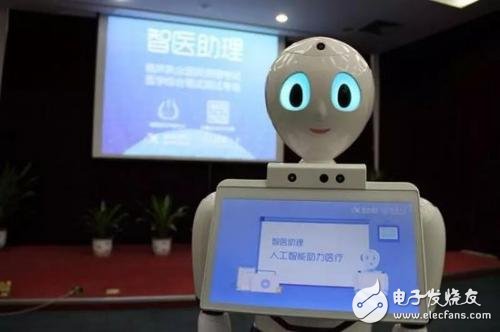Recently, the "Intelligent Assistant" robot of the University of Science and Technology has officially started an "internship" in the Fuyang District of Hefei, assisting the grassroots general practitioners to complete the medical work every day.
It is understood that the "Intelligent Assistant" artificial intelligence assisted diagnosis and treatment system was jointly developed by Keda Xunfei and Tsinghua University. It can quickly generate an electronic medical record based on the dialogue between doctors and patients and give a diagnosis of the condition. The doctor is seeing the "medical assistant". After the diagnosis, confirm the diagnosis, and then you can check the patient's medical history through the “wisdom assistantâ€, and you can also check similar cases, clinical guidelines and drugs for the symptomatic use.
According to the official voice of Science and Technology, the “Intelligent Assistant†can generate electronic medical records in the process of communication between doctors and patients, and automatically extract the condition according to the communication information of doctors and patients.
Through cognitive intelligence-related technologies, “Intelligent Assistant†has comprehensively studied a large amount of relevant materials such as medical textbooks, clinical guides and classic cases, and has mastered a large amount of medical knowledge to provide doctors with differential diagnosis, thus helping doctors to improve the quality of diagnosis and treatment. The rate of treatment.
In addition, for chronic diseases and other key populations, the “Intelligent Doctor Assistant†will automatically follow up the patients and community residents according to the follow-up plan developed by the family doctor, assist the doctors in tracking and health management of the residents, and improve the health records of residents and other medical institutions. data.
According to Yibang Power Network, the last "Intelligent Assistant" robot was unveiled because it passed the national written examination for the qualification examination of the National Physician Qualification Examination with 96 points exceeding the qualified line, and became the first person in the country to pass the national qualification examination for medical practitioners. smart robot.

Xunfei “Intelligent Assistant†robot passed the written test and verified the remarkable progress made by HKUST in two aspects:
First, the ability to learn knowledge: using the "multi-semantic deep learning" algorithm, from the five-year medical undergraduate of the People's Medical Publishing House, all the textbooks, clinical guidelines, classic cases and other information to obtain the knowledge representation and relationship representation of the medical concept, let the machine own a huge medical knowledge base;
Second, the ability to use knowledge: the use of multi-scale fusion reasoning algorithms including "keypoint semantic reasoning", "context semantic reasoning", "evidence chain semantic reasoning", so that the machine has the multi-level reasoning ability of paragraphs and chapters.
Lu Xiaoliang, deputy general manager of Keda Xunfei Medical, once described to Yibang Power Network that the new model of artificial intelligence diagnosis and treatment envisaged by HKUST is like this: in the process of communication between doctors and patients, doctors and patients are diagnosed through intelligent speech technology. Communication from voice to text, extracting information from within, combined with machine learning and medical image processing capabilities, combined with deep learning decision-making capabilities, provides advice and thinking for doctors' diagnosis and treatment.
This model is reflected in the application of “flying doctor assistantâ€.
The University of Science and Technology has a very fast landing in the medical field.
As early as June 2016, Keda Xunfei and Anhui Provincial Hospital established the "Medical Artificial Intelligence Joint Laboratory", relying on a number of technological innovations of the University of Science and Technology and the medical resources of Anhui Provincial Hospital to carry out joint scientific research.
One year later, Keda Xunfei and Anhui Provincial Hospital jointly created Anhui Provincial Wisdom Hospital, which has been docked with the Anhui Medical Imaging Cloud Platform and the Anhui Provincial Hospital Medical Association Remote Consultation Platform, and officially connected to the province. County-level hospital.
The products that the smart hospital has landed include: intelligent medical guidance medical robot “Xiao medicineâ€, artificial intelligence medical image assisted diagnosis system, outpatient voice electronic medical record, oral/ultrasound voice assistant, cloud medical sound mobile medical workstation.
Lithium thermal battery is a rechargeable and dischargeable secondary battery that mainly relies on the movement of lithium ions between the positive and negative electrodes. Cathode material has always been the core material of lithium-ion batteries. Its choice directly determines the performance of the battery. At present, lithium cobalt oxide, lithium manganate, lithium iron phosphate, nickel cobalt manganese/aluminum ternary materials and other lithium compounds are common The cathode material.
The negative electrode material is mainly used for the storage and release of battery energy, and is also an important part of the battery. At present, anode materials are mainly divided into carbon materials for commercial applications and non-carbon anode materials such as silicon-based materials, alloy materials, and tin-gold materials that are under research and development. The positive and negative materials of lithium batteries are synergistic with each other, which together affect the performance of lithium-ion batteries, and are ultimately used in new energy vehicles, energy storage devices, electronic products and other fields.
Shandong Huachuang Times Optoelectronics Technology Co., Ltd. , https://www.dadncell.com